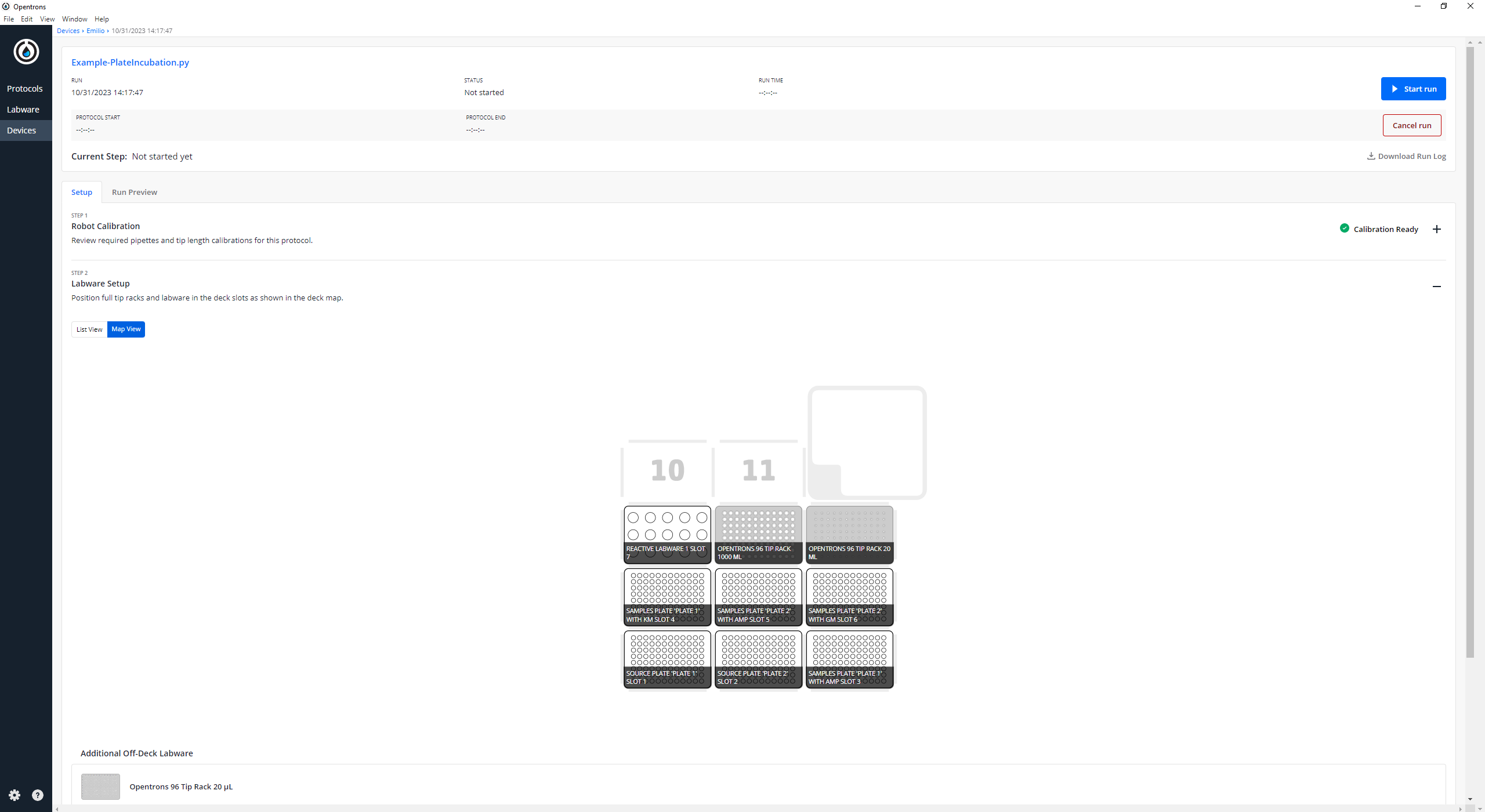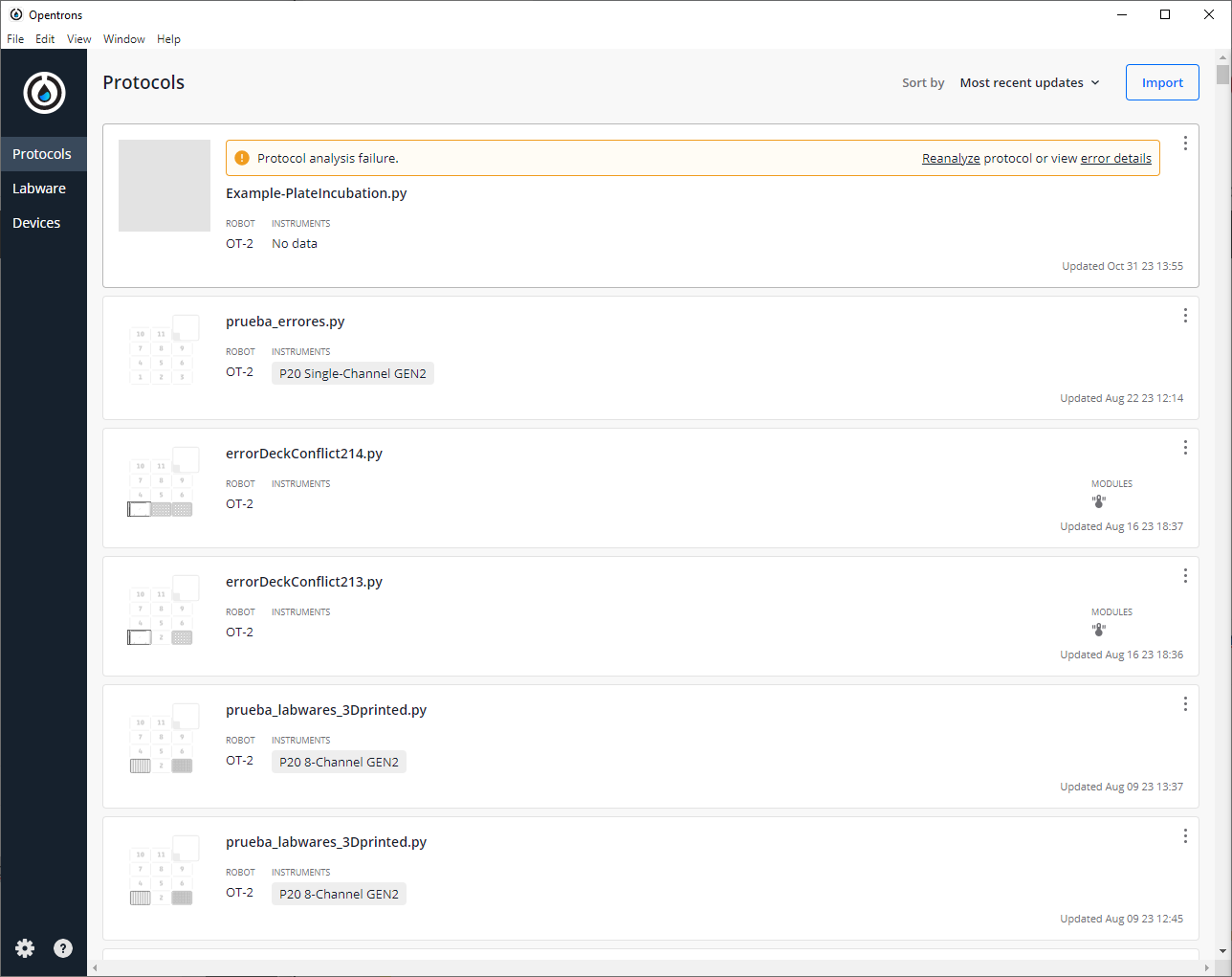OT-2 Media dispensing and culture inoculation protocol
Ana Mariya Anhel, Lorea Alejaldre, Ángel Goñi-Moreno
Abstract
This protocol is meant to distribute reactive(s) into well plates with a single channel pipette, and then transfer culture samples from source plate(s) to these plates with a multi-channel pipette.
This protocol uses a python script for an Opentrons 2 robot and an excel file containing the required variables to set the number of samples, volumes of transfer, type of plates, etc...
In our laboratory, this protocol has been used as part of the "High-throughput workflow for the genotypic characterization of transposon library variants" also available in protocols.io to prepare cultures plates to perform a subsequent counter-selection
This protocol is a set of instructions or description of the LAP repository entry LAP-CellMediaInoculation-OT2-1.0.0
Before start
Note that the source and final 96-well plates will follow the same order (If the wells of a column of the source plates has empty wells the multichannel will aspirate in that well) but media will not be dispensed in those corrresponding final wells
Steps
Select Robot to Perform Script
Click in the protocol > Run Protocol > Choose the OT where the file VariablesPlateIncubation.xlsx is > Proceed To Setup
After clicking in Proceed to Setup you should obtain the positions of the labware, in the Labware Setup tab, and the reactives, with their correspondant volume, in the Liquid Setup tab.
In case that the protocol with the set variables is not possible to run, an error will occur during the run. A lot of errors are contemplated already and have a specific message that give a hint of what could have gone wrong.
Files Preparation
Preparing Customized Template
Preparing the template (a .xlsx) with the specific variables for each experiment and a .pdf that contains the instructions on how to fill the template
Here we attach one Excel with several sheets:
- GeneralVariables: variables related mainly to the labware that is going to be used
- PipetteVariables: variables related to the pipettes that are going to be used
- PerPlateVariables: variables associated with the specifications of each source plate
Fill the template with the corresponding values
Store it as VariablesPlateIncubation.xlsx
Transferring file to Robot
Transfer the VariablesPlateIncubation.xlsx to the directory /data/user_storage of the OT system that we will use to perform the protocol.
Here, we present a summary of how to transfer the files in 3 OS: Windows, MacOS and Linux .
MacOS/Linux
We will use the command line with scp to transfer the file VariablesPlateIncubation.xlsx to the OT system.
We need to perform the following command
#Passing Files to OT
scp -i [ot_key path] [file path] root@[IP_OT]:/data/user_storage
#Transferring files to OT (MacOS 13 and 14)scp -Oi [ot_keypath] [file path] root@[OP_robot]:/data/user_storageWindows
There are several ways to send files from a Windows to a Linux (for example, with a virtual machine or Windows Powershell in the latest versions of Windows).
Here, we will use FileZilla (https://filezilla-project.org/download.php?type=client).
Go to File -> Site Manager -> New Site -> Change Protocol to SFTP . Then, introduce in Host the OT IP, change Logon Type to key file, change User to root and give the directory where the OT-key file is. The final window should look something like the following picture
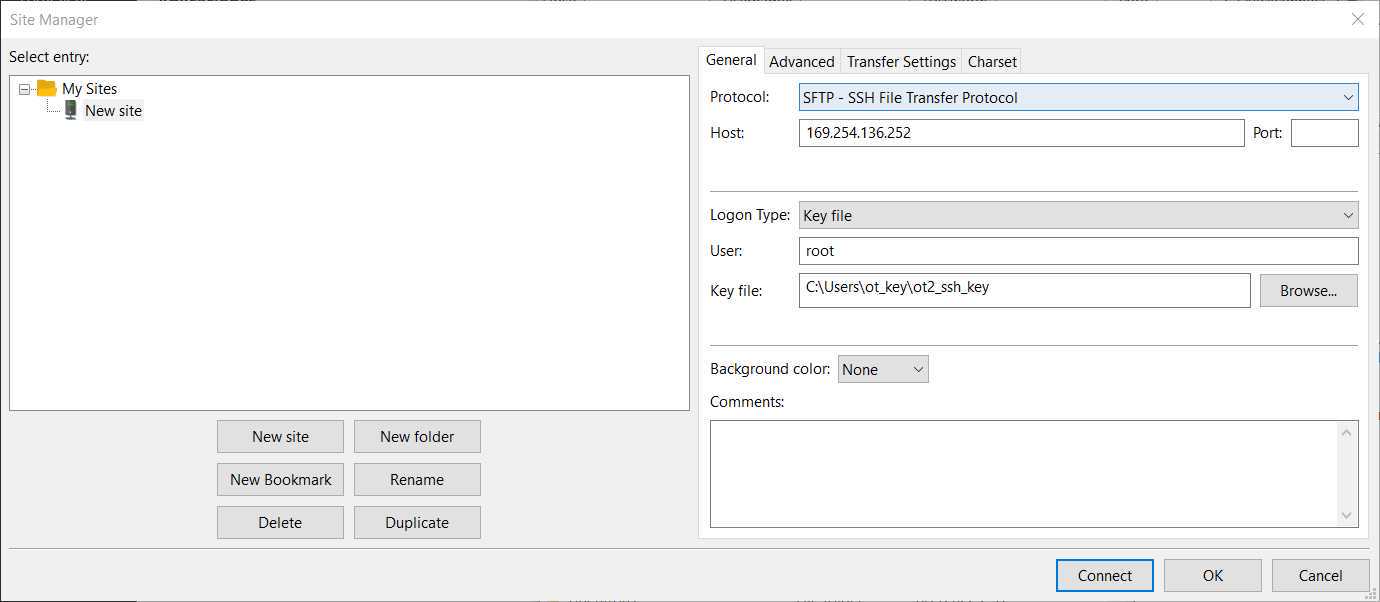
Then press Connect, and we will have a connection between our computer and the robot.
After this connection, we should be able to transfer VariablesPlateIncubation.xlsx (in our computer) to the directory /data/user_storage in the robot.
This method of transferring files can also be done in Linux and MacOS.
Adding the custom labware
There is only a need to do this step when the labware you are using is not OT official or included in the OT app.
Creation of .json file
The description file can be obtained by describing the labware dimensions at https://labware.opentrons.com/create/
Uploading files to the OT-app
In the OT app, we need to perform the following route: Labware -> Import -> Choose File -> Select file we have created in step 3.1
Transfer labware files to the robot
If you are using the entry LAP-CellMediaInoculation-OT2-1.0.0 and custom labware , an additional step is needed, which is transferring a folder with the custom labware.
We need to create for our custom labware a folder with the API name containing the description file (.json) called 1.json and then transfer that folder to the robot's folder /data/labware/v2/custom_definitions/custom_beta in a similar way as in the Step 2 but with the difference that is a directory that needs to be transferred and not a file.
#Transferring the custom labware to OT (Linux)
scp -i [ot_key] -r [directory_custom_labware] root@[IP_OT]:/data/labware/v2/custom_definitions/custom_beta
Prepare Robot OS
Install needed packages
This script needs the package openpyxl , which is not installed by default in the OT-2 robots
Connect to the robot
to find the IP of the robot in which you want to run the script
To connect to the robot, you can do it via ssh with the following command
#Connect to Linux based OT via ssh
ssh -i [path ot_key] root@[Robot_IP]
```In Windows, you can do this command in Windows Powershell
<Note title="Citation" type="success" ><span>If the connection has been successful, you should obtain a screen similar to the following image</span><span></span><img src="https://static.yanyin.tech/literature_test/protocol_io_true/protocols.io.q26g7yb3kgwz/pd7ubxsu718.jpg" alt="Drawing obtained when entering an OT-2 system" loading="lazy" title="Drawing obtained when entering an OT-2 system"/></Note>
Install the package
Once inside the robot's system, you need to run the following command
#Install openpyxl package (Linux 4.14.74-v7)
pip install openpyxl
Run Protocol
Load script in OT-App
Now that we have transferred the variable files to the robot, we can load the script and run it in the selected robot
Software
| Value | Label |
|---|---|
| Opentrons App | NAME |
| Windows >=10, Mac >=10 | OS_NAME |
| , Ubuntu >=12.04 | OS_VERSION |
| https://opentrons.com/ot-app/ | REPOSITORY |
| Opentrons | DEVELOPER |
Load the script in the App
Protocols -> Import -> Drag Python script
Software
| Value | Label |
|---|---|
| LAP Repository | NAME |
| www.laprepo.com | REPOSITORY |
| https://biocomputationlab.com/ | DEVELOPER |
Select Robot to Perform Script
Click in the protocol -> Start setup -> Choose the OT where the file VariablesPlateIncubation.xlsx is -> Proceed To Setup
After clicking on Proceed to Setup, you should obtain the labware positions in the Labware tab and the reagents, with their corresponding volume, in the Liquids tab.
In case the protocol with the set variables cannot run, an error will occur during the run. Many errors are contemplated already and have a specific message that hints at what could have gone wrong.
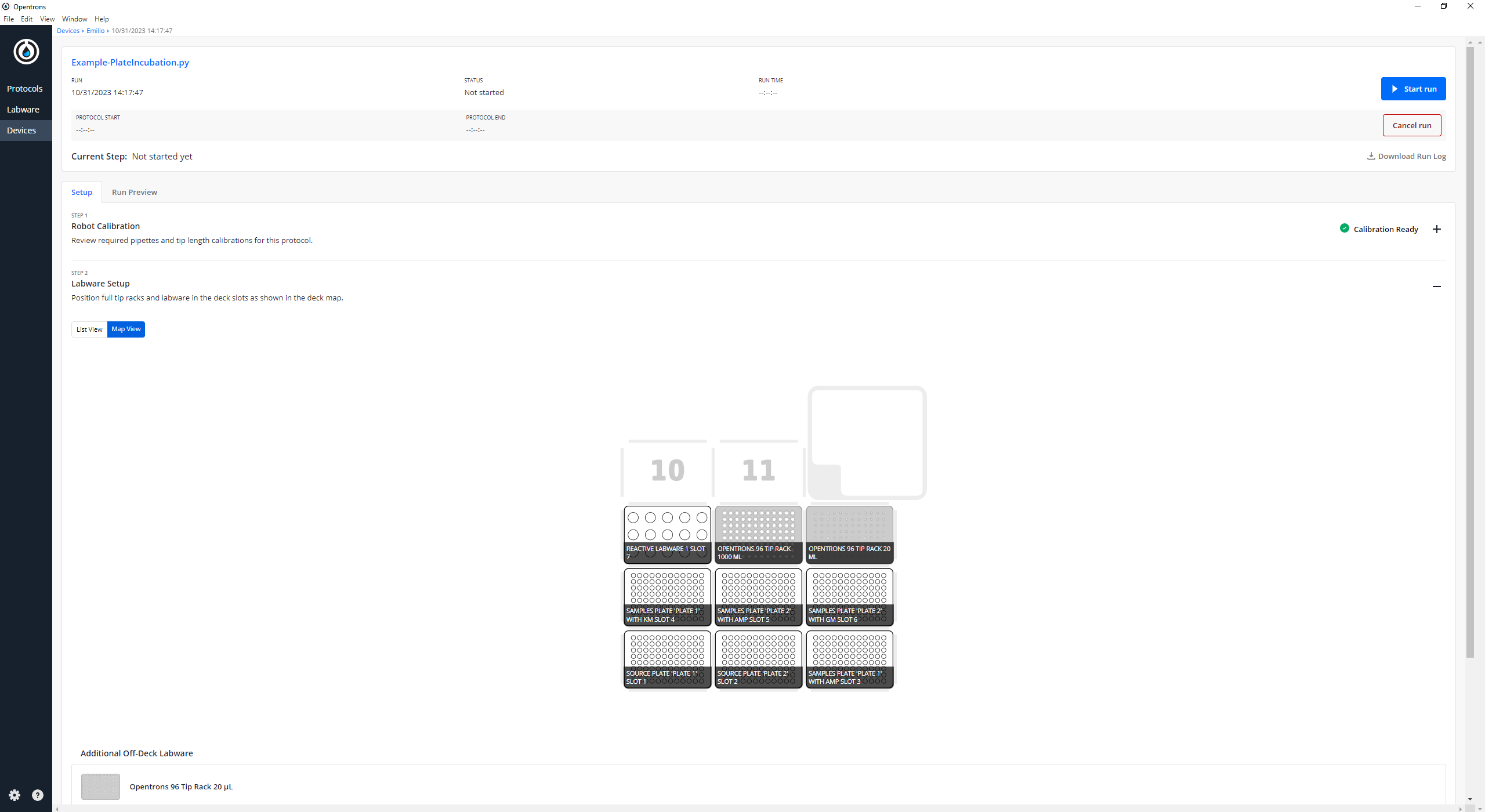
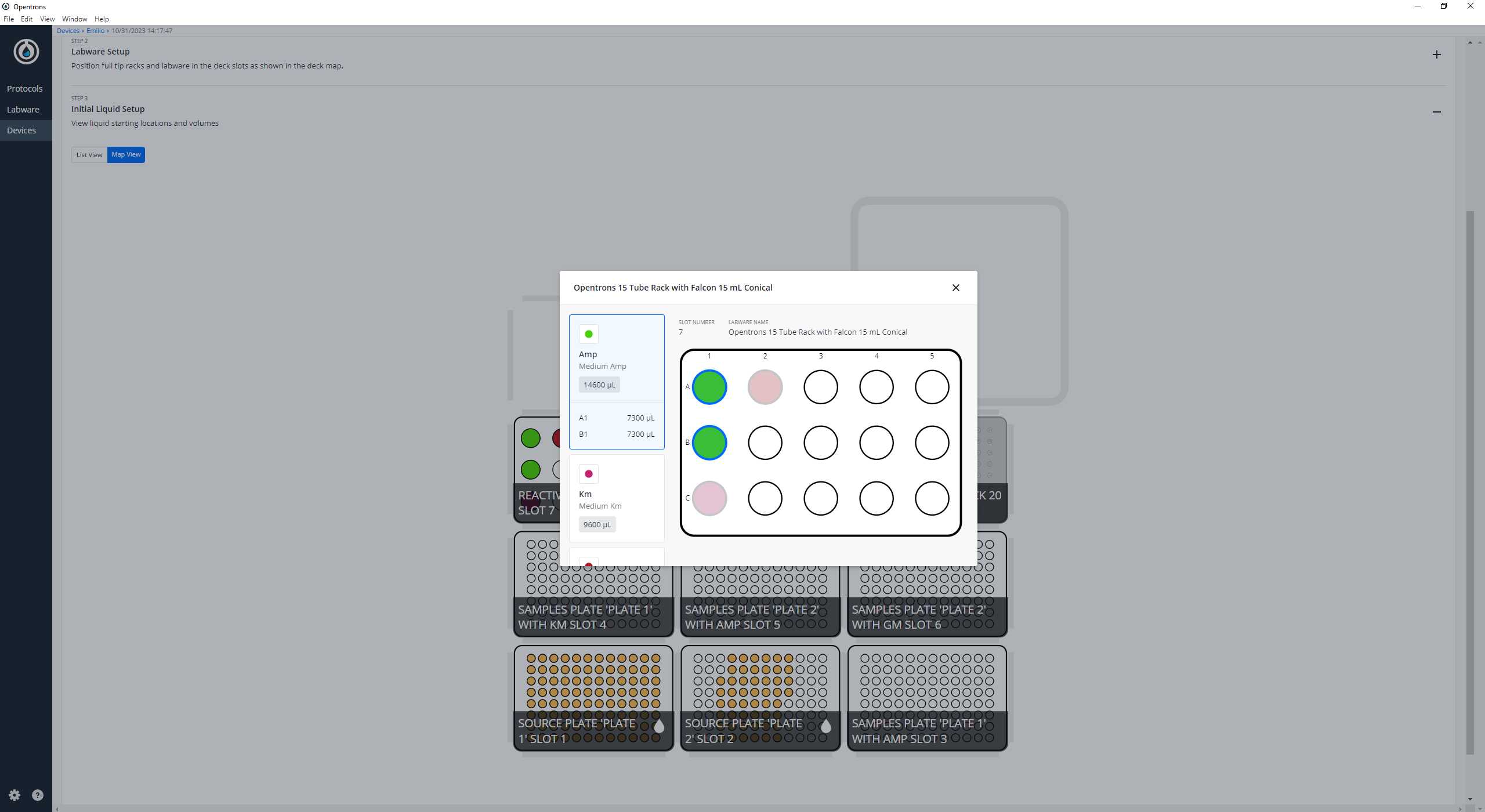
Run Protocol in OT
Make sure the needed calibrations are done
Pipettes, tip racks and tip length calibrations need to be done for the items used in this run.
Labware position check is performed (if needed)
Clean the surface of the robot with 70% ethanol to clean and disinfect the surfaces
Set the labware and reagents as shown in the OT-App
Start Run
The procedure that the robot is going to do is mainly divided into 2 parts:
- Distribute each reactive to the final plate(s) with the single-channel pipette
- Distribute samples to the final plate(s) with the multi-channel pipette
After-Running
Retrieve labware from the OT
Example
We want to transfer samples from 2 source plates, with 96 and 50 samples , to different antibiotic plates, one per antibiotic and source plate.
The first one will be mixed with Ampicillin and Kanamycin. The second plate will be mixed with Ampicillin and Gentamycin .
We will use a computer with a Windows 10 system.
Excel template that we can find filled with the name VariablesPlateIncubation.xlsx
Start Run
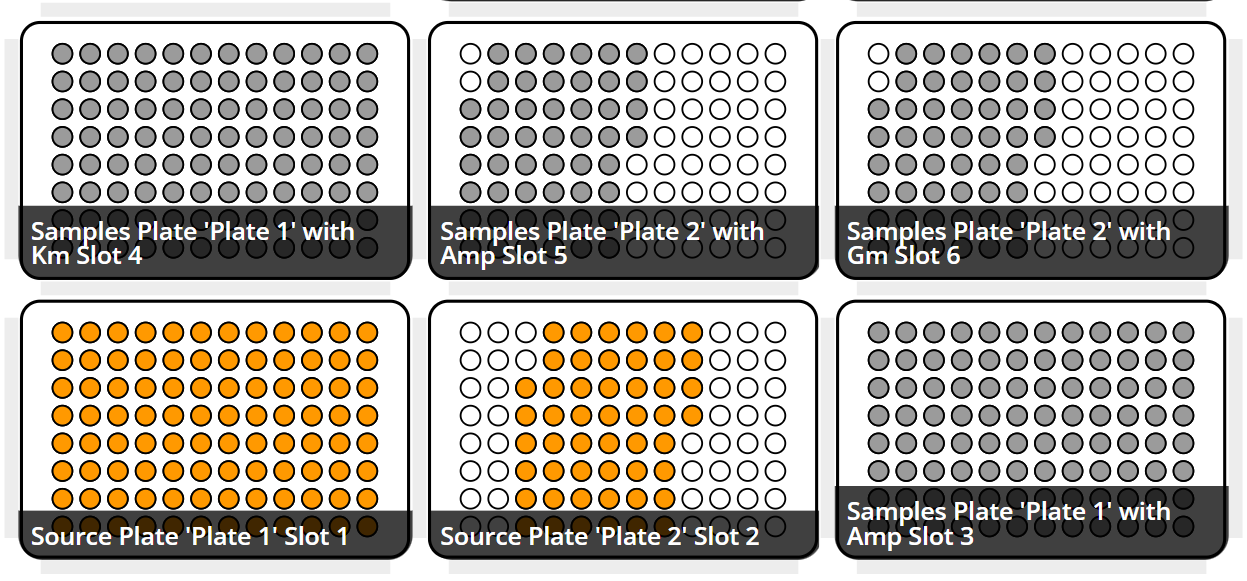

Retrieve labwares from the OT
Upload custom labware to app
We are using a custom labware called vwrblueprintdepth105_96_wellplate_390ul that has been created with the labware creator that opentrons offers (https://labware.opentrons.com/create/)
vwrblueprintdepth105_96_wellplate_390ul.json
Upload it to the labware and ensure it is loaded in the app.

Because we are using version 1.0.0 of the script in this example, we will transfer the directory of the labware as well (here we have attached a zip, but it is the folder that must be transferred, not the zip)
vwrblueprintdepth105_96_wellplate_390ul.zip
#Transferring the used custom labware to OT (Linux)
scp -i [ot_key] -r vwrblueprintdepth105_96_wellplate_390ul root@[IP_OT]:/data/labware/v2/custom_definitions/custom_beta
Run the protocol in the robot that we have transferred the Excel file
Example-PlateIncubation.py Example-PlateIncubation.py -> Start setup -> Select the robot in which we are going to run the protocol
If we do not have any errors, the output should look like the following pictures.
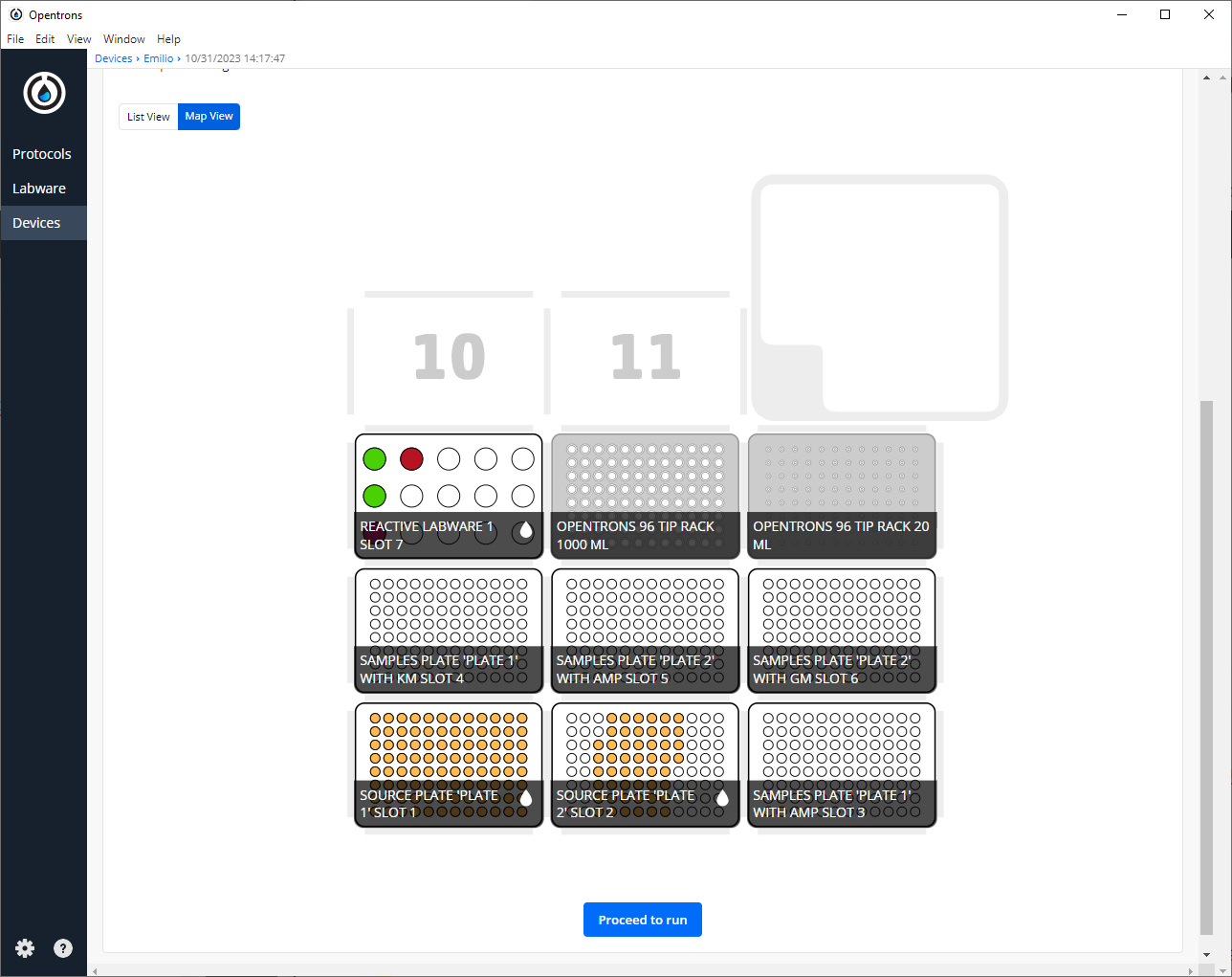

Turn the HEPA filter module
Clean platform of the robot that we are going to perform the protocol
Prepare all reagents and labware in the places the App is showing and take into account the notes in step
